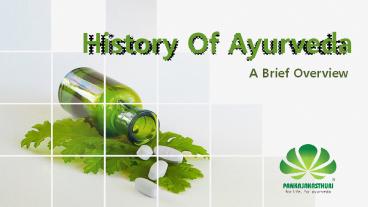History Of Ayurveda - PowerPoint PPT Presentation
Title:
History Of Ayurveda
Description:
Ayurveda, one of the oldest traditional systems of medicine, originated in the Indian subcontinent. Ayurveda was mainly practised by the sages during the Vedic civilisation. It is said that the main source of knowledge for Ayurveda was derived from the Vedas, the holy books of knowledge. – PowerPoint PPT presentation
Number of Views:4464
Title: History Of Ayurveda
1
History Of Ayurveda
A Brief Overview
2
History and Evolution of Ayurveda
- Historical Aspect
- Ayurveda has been practised by Indians since 2nd
Century BC and its origin can be traced back to
Vaisheshika, an ancient school of Hindu
philosophical teachings and the Nyaya, the school
of logic. Vaisheshika spoke about perceptions
and inferences. This school of thought
characterized the attributes of any
object into 6 types. These are - Substance or Dravya Quality or
Guna Activity or Karma Generality or
Samanya Particularity or Vishesha
Inherence or Samavaya - This new school of thought is believed to
propagate the knowledge of Ayurveda throughout
the country.
3
History and Evolution of Ayurveda
- Mythological Aspect
- It is believed that Ayurveda owes its origin to
Brahma, the God who created the universe as per
the Hindu Mythology. It was Brahma who passed
this knowledge of Ayurveda to the sages for the
well- being of the humans. The sages then
passed this knowledge to their disciples and then
to the common man. - They composed all the information about the herbs
and medicines in form of Shlokas or hymns. - It is believed that all the compilations related
to healing and medicines were contained in the
four Vedas Rig Veda, Yajur Veda, Sama
Veda and the Atharva Veda.
4
Ayurveda In India
- It was around 1500 to 1000 BC when Ayurveda in
India developed. It followed a same developmental
phase as the Chinese and the Western medicine
(evolving from religious and mythological
discipline and then moving into the medical
system). The two schools of medicine that was
found during this period were the Atreya
(school of the physicians) and Dhanvantari
(school of the surgeons).
5
Ayurveda In India
- Agnivesha who systematised all the knowledge of
Ayurveda from the Vedas which was the edited by
Charaka and other scholars, its currently known
as Charaka Samhita and contains all the
knowledge pertaining to the different aspects
of Ayurvedic medicines. - Another important compilation is Sushruta
Samhita, which is all about the science of
surgery. Sushruta compiled the teachings of
Dhanvantari in Sushruta Samhita. These 2
legendary books are being followed by
Ayurvedic practitioners till this date.
6
Sections Of Ayurveda
- The Ashtanga Sangraha and the Ashtanga Hrudayam
- Written by Vridha Vagbhata, a disciple of
Charaka, Ashtanga refers to 8 sections of
Ayurveda - Internal Medicine Kaya Chikitsa
- Paediatrics Bala Chikitsa
- Psychiatry Graha Chikitsa
- ENT Ophthalmology Salakya Thantra
- Surgery Salya Thantra
- Toxicology Agada Thantra
- Geriatrics Jara Chikitsa
- Aphrodisiac therapy Vajeekarana Chikitsa
7
Proliferation of Ayurveda
- 8000 BCE 1000CE - Golden Era Of Indian
Medicines - Most important books on Ayurveda were produced
and circulated throughout the world during this
era. - Indian medicine became popular amongst Greeks,
Egyptians, Chinese, Roman, Persians, Arabs, and
Tibetans who travelled to India during that
time. - Between 1000 CE and 1200 CE, physicians such as
Avicenna and Razes translated a great part of the
Ayurvedic knowledge into Arabic. - Junior Triad of Ayurveda was written durig this
period - Madhava Nidana
- Sarangdhar Samhita
- Bhavaprakasham
8
Ayurveda During British Rule
- Ayurvedic practices were supported by the then
Government, it thwarted the further evolution of
Indian Sciences. - In the latter half of British rule, Ayurveda
again drew the attention of scholars throughout
the world. - New institutes were established and now, there
are hundreds of Ayurvedic institutes all over the
country.
9
Ayurveda During Current Time
- A major part of the Indian population relies on
Ayurvedic medicines for healing. Containing all
the goodness of medicinal herbs, these
products are 100 natural.
10
For more information, visit http//www.pankajaka
sthuri.in/































